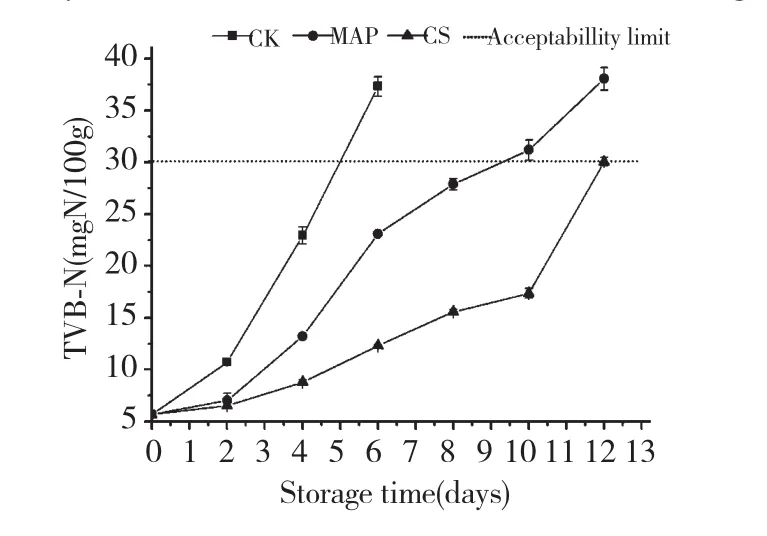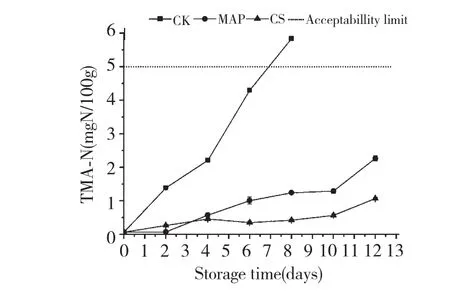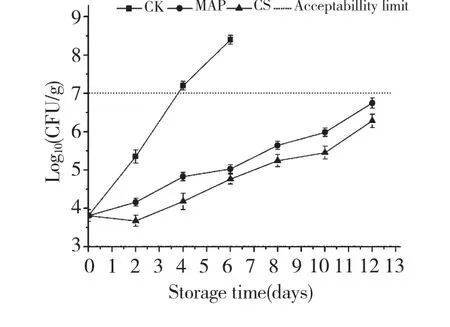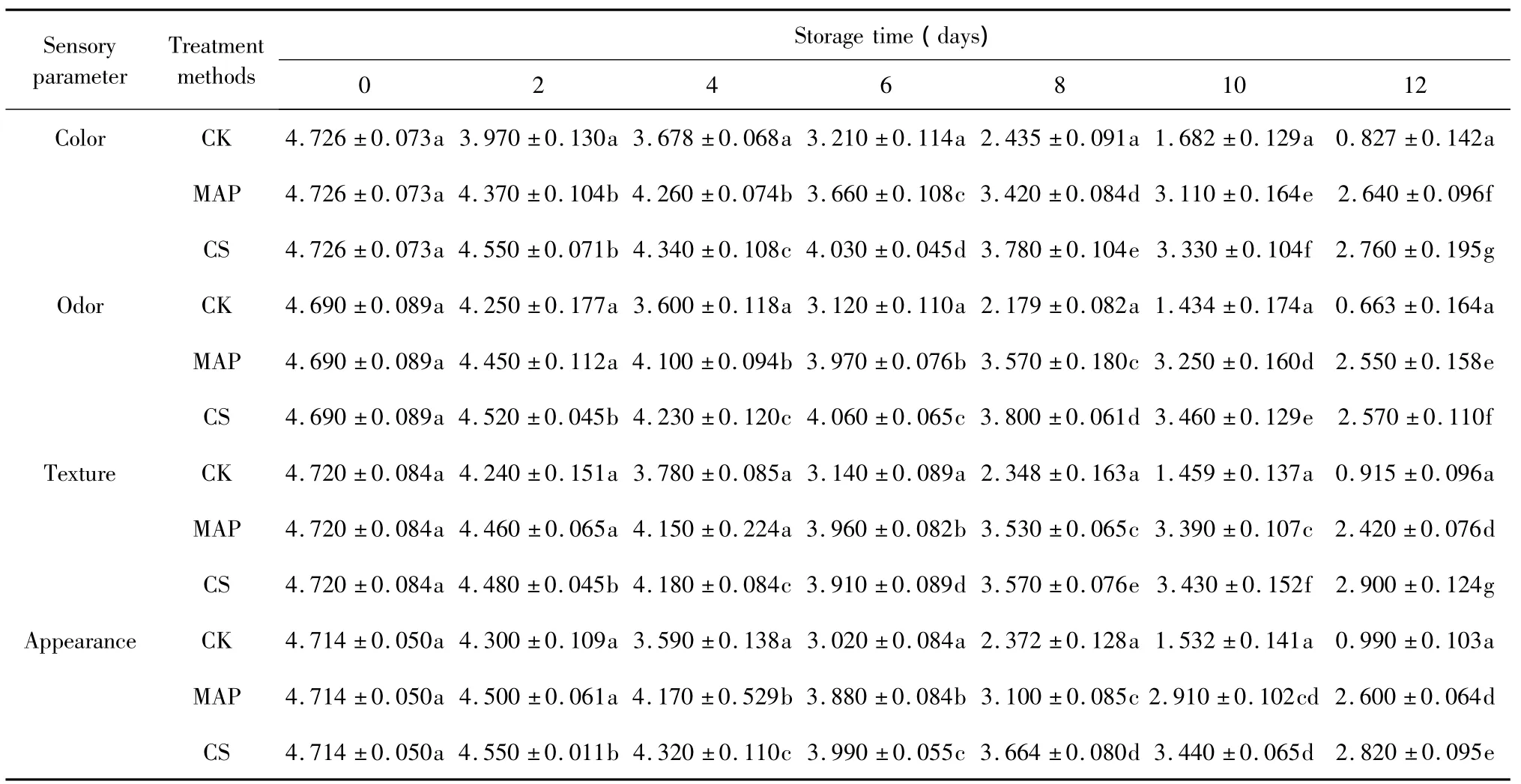Effects of M odified Atmosphere and Chitosan Edible Coating on Quality of Pom fret(Pampus argenteus)Fillets During Chilled Storage
2015-05-17LANWeiqingCHEXuWANGTingXIEJingZHURuiqiZHUFeng1ShanghaiEngineeringResearchCenterofAquaticProductProcessingPreservationCollegeofFoodScienceTechnologyShanghaiOceanUniversityShanghai01306China
LANWei-qing,CHE Xu,WANG Ting,XIE Jing* ,ZHU Rui-qi,ZHU Feng1 Shanghai Engineering Research Center of Aquatic Product Processing&Preservation; College of Food Science & Technology,ShanghaiOcean University,Shanghai01306,China
蓝蔚青1,2,车 旭2,王 婷2,谢 晶1,2*,朱瑞琪2,朱 峰2
1上海水产品加工及贮藏工程技术研究中心;2上海海洋大学食品学院,上海201306
Introduction
Pomfret(Pampus argenteus)is extensively distributed along China coastline,aswell as in Indian Ocean,Arabian Gulf and North Sea[1,2].It is used to be considered as primary marine fishery resources with the high economic interest in China,together with Pseudosciaena crocea,Trichiurus haumela and Sepia.Like other seafood,fresh pomfret is highly perishable due tomicrobial activity and spoilage-specific chemical reactions,and thus has limited shelf-life.It is necessary to take the appropriatemethods to extend the preservation period of pomfret and delay the decline of its quality.
Modified atmosphere packaging(MAP)technology is developed to slow down the growth of aerobic organisms and oxidation rate,and hence improve the quality of stored fresh foods to some extent[3-6].MAP combined with chilled storage could prolong the shelf-life of seafood products bymodifying the concentrations of O2,N2and CO2.There are several researches about the MAP of aquatic products,e.g.turbot(Psetta maxima)[7],striped red mullet(Mullus surmuletus)[8],Atlantic salmon(Salmo salar L.)[9-11],barramundi(Lates calcarifer)[12],bluefin tuna[13],striped catfish[14],lingcod(Ophiodon elongates)[15],red claw crayfish(Cherax quadricarinatus)[16],eel(Anguilla anguilla)[17]and chub mackerel(Scomber japonicus)[18].
In recent years,chemical preservatives are notwell ac-cepted by consumers for the toxic effects.There has been an increasing interest in the application of various natural agents as a bio-preservative.Chitosan was extensively found in crustaceans,such as shrimp,crab and others,which was obtained by deacetylate reaction of chitin as a national food additive for having a broad range of applications in the food industry without harm and toxicity[19].It exhibits antimicrobial activity againsta range of food-bornemicroorganisms and has attracted attention as a potential natural food preservative consequently,which used in the field of food preservation and film packaging widely[16,20].However,there were few studies concerning with the research on MAP and chitosan to the quality of pomfret.The aim of this study was to experimentally assess several quality indices(pH,K-value,TVB-N,TMA-N,TVC,Sensory evaluation)of fresh pom fret fillets,the impact of MAP and CS on its quality were also evaluated during chilled storage.
M aterials and M ethods
M aterials
Fish sample
Fresh pomfret(Pampus argenteus)samples were obtained from the local fish market(Luchao Harbor,Shanghai,China)in April2014 with amean weight varying from 200 to 250 g.Sampleswere arrival at the laboratory in ice for 30 min.They were immediately gutted,washed,filleted and trimmed in a water-ice mixture,the samples had a weight about 100 g(15 cm in length and 10 cm in width),and then be randomly divided into three lots in ice and packaged using for different treatments.
Chemicals
Chitosan(in powder form,average molecular weight of chitosan was 1.6 ×105Da and its deacetylation degree wasmore than 90%,Sino-pharm chemical Reagent Co.Ltd.,China);Plate count agar(Land-Bridge Technology Co.,Ltd.,Beijing,China);70%methanol,Trichloroacetic acid(TCA),Lightmagnesium oxide,boric acid,95%ethanol,sodium chloride,potassium hydroxide(Sino-pharm chemical Reagent Co.Ltd.,China).Instruments
Sartorius PB-10 pH meter(Sartorius Scientific Instruments Co.,Ltd.,Germany);Unico-2100(Unico Instruments Co.,Ltd.,Shanghai,China);LC-2010HT High pressure liquid chromatography(HPLC,Shimadzu Corporation,Japan);LHS-100CL Constant temperature and humidity box(Yiheng Scientific Instrument Co.,Ltd.,Shanghai);AUW320 Analytical balance(Shimadzu Corporation,Japan);Kjeltec8400 Kjeldahl apparatus(FOSS Co.,Ltd.,Shanghai,China);H-2050R High speed low temperature centrifuge(Hunan Xiangyi Laboratory Instrument Development Co.Ltd.,China).
Preparation of Fish samples
One lot was stored in air(CK),the second lot was modified atmosphere packaged with 80%CO2/20%N2(MAP),the final gas/sample ratio in all pouches was about2∶1(v/w)for MAP condition,the third lot was coated with 10.0g/L chitosan(CS,Chitosan was dissolved in sterile water with 1.0%acetic acid and the final concentration was 10.0 g/L).All samples were stored in a refrigerator with controlled temperature(4±1 ℃)for 6-14 days.Quality assessments of samples from 3 groupswere determinated by chemical(pH value,K-value,total volatile basis nitrogen and tri-methylamine),microbiological(Total Viable Count)and sensory evaluation for over 12 days at2-day intervals.
Chem ical analysis
Determination of pH value
5 g sample of the fish flesh was homogenized andmixed with 45 mL of boiled distilled water.The mixture was filtered 30 minutes later and the filtrate wasmeasured using Sartorius PB-10 pH meter.
K value
ATP and its breakdown productswere analyzed according to themodified method[21].K-value was defined as the percentage of inosine(HxR)and hypoxanthine(Hx)to the sum of ATP and degradation products,the formula used was as follows:

Determination of Total volatile basic nitrogen(TVB-N)Total volatile basic nitrogen(TVB-N)was estimated by the micro-diffusion method with Kjeltec 2300.The micro-diffusion method[22]was determined by distillation after adding MgO to the homogenized samples.TVB-N valueswere expressed asmg TVB-N per 100 g fish muscle.
Determination of TMA-N
Tri-methylamine nitrogen(TMA-N)was measured using the method of spectrophotometer[23].Potassium hydroxide was used to reduce the interference of dimethylamine.1gminced fish muscle was extracted with a trichloroacetic acid solution(40%,w/v)at8,000 rpm for 1min.Themixture was filtered.10 mL of toluene,1 mL of formaldehyde(10%,v/v)and 3 mL potassium hydroxide solution(45%,w/v)were added to 5 mL of filtrate.Toluene layer was transferred to another tube and 5 mL of picric acid solution(0.2 g/L)was added after shaking,the results of absorbance were read at 410 nm.A calibration curve with a trimethylamine hydrochloride solution(0.01 mg/mL)was prepared to quantify TMA-N according to the AOAC method.The resultswere expressed as TMA-N/100 g of fish.
Bacteriological analysis
Total viable count(TVC)is an indicator of degradation,which ismostly due to the growth of specific spoilage organisms(SSO)in seafood[24].According to GB 47892-2010,25 g Fish samples were transferred to a stomacher bag.225 mL of 0.1%peptone water with salt(NaCl,0.85%,w/v)were added and homogenized for60 swith a stomacher.Other decimal dilutions were obtained from this dilution and 1mL of three dilutions was transferred in triplicate to Petri dishes containing 15 mL commercial PCA.Total viable counts(TVC)were determined by counting the number of colony-forming units after incubation at30℃ for 72 h.
Sensory evaluation
The acceptability of marine food was determinated by the changes of samples in their sensory attributes.Sensory evaluation was carried out according to SC/T 3103-2010[25],and fish samples were calculated using the quality index method(QIM)based on the freshness quality grading system[21]by five trained panelists.The sensory assessment approach evaluates the freshness by giving demerit points according to certain aspects of flesh color,odor,texture and hardness respectively(Table 1)[26].The sensory scores were ranged from 1 to amaximum of 5,where 5 represented the freshest quality and the scores increased according to spoilage up to 3 for each parameter.Panelists were asked to describe whether the fish samples were acceptable or not,thiswas used to determine the shelf-life of pomfret fillets.

Table 1 Sensory evaluation of pom fret fillet
Statistical analysis
Data were expressed asmean values(n=3)accompanied by standard deviation.Analyses were performed with the SPSS software(version 13.0)(SPSS,Chicago,IL,USA)to detect significant differences between lots and periods of cold storage.One-way analysis of variance was used,the Turkey multiple comparison test was used to find significant differences between lots.Significance level was set at 0.05.The figures were drawn as origin software(Version Pro V8.5).
Results and Discussion
pH value
Changes in pH values during storagewere shown in Table 2.The initial pH of the fish samples was 7.23 ±0.01.The pH values of CK and CS decreased slightly at early stages and then increased gradually.The initial decrease of pH might be related to the accumulation of lactic acid,a product of glycolysis,while the increase during later storage may be caused by the growth of spoilage bacteria leading to the accumulation of alkaline components,such as ammonia and tri-methylamine.

Table 2 pH value of pom fret fillets from different treatments stored at 4±1℃
The variation of pH in CSsampleswas slower than control samples,which revealed that chitosan could inhibit the growth of spoilage bacteria and prolong the shelflife of pomfret samples.However,significant correlation(P <0.05)was not found in MAP lot.The results suggested that examination of pH could not be a useful indicator of quality changes in pomfret fillets from MA packaging.Similar observations were reported[27-31],most fish contain only very little carbohydrate(>0.5%)in the muscle tissue and only small quantities of lactic acid were produced post-mortem[32].The results indicated that pH values of differentmethods increased after the values reached the minimum on day 2,especially the control group increased much faster because glycolysis reaction caused by the stop in circulation of blood and produced large amounts of lactic acid,succinic acid,phosphoric acid,thus leading to enhancement of organism acid and decrease of pH value.With the extension of storage time,protein decomposition produced amine and other alkali substances because of the increase inmicroorganisms and enzyme activity,which led to the gradual increase of pH value.CO2could inhibit the increase of microorganisms,enzyme activity and slow down the increase of pH value.
K-value
Variations in K-value during chilled storagewere shown in Fig.1.The amountofmicroorganismswas few in early storage and the effect of different preservatives on enzyme degraded from ATP in the pomfret filletwas various.Therefore,the resolution of ATP was accelerated with the mass propagation of microorganisms in later storage.K-value was the index of degradation of ATP and used as the most effective indicator for the freshness in fish.When the K-value was close to the 60%limit,the sample will reach the rejection level[33].

Fig.1 K-value of pom fret fillets from different treatments stored at 4±1℃
Initial K-value in fish sampleswas6.3%,which reflected the fresh of pomfret samples.The K-value of control samples were 57.91% before day 4 and increased much faster than other groups(P <0.05)during storage.It can be concluded that the lower K-value ofMAP samplesmay result from the slower ATP degradation by the effect of CO2/N2treatments on the fish samples.The result of the data also indicated that MAP was e-qually effective in inhibiting the degradation of ATP and extending the chilled storage life of fish samples.Moreover,the K-value of CSgroup increased slowly and could not exceed the acceptance limit on day 12.The result showed that10 g/L chitosan was effective in inhibiting the degradation of ATP and extending the cold storage life of fish samples.
Total volatile basic nitrogen(TVB-N)
Changes in TVB-N of pomfrets during storage were shown in Fig.2,TVB-N includes the measurements of TMA(tri-methylamine),DMA(di-methylamine),ammonia and other volatile basic nitrogen compounds and has been reported as spoilage compounds and proposed as fish and shellfish spoilage indicator in many studies[34].The initial TVB-N value of control samples was 5.663 ±0.28mgN/100 g.No significant difference between control and treated samples was detected before storage(P <0.05).TVB-N values of the control samples increased rapidly and by day 6 exceeded the acceptance limits.TVB-N ofMAPand CS treated samples increased slower in the first days,and a lag phase of about 2 days was observed.The shelf-life of CK,MAP and CS samples were 4,8,12 days.The concentration of CO2was act on the characteristic ofmicroorganism effectively and inhibited the increase ofmicroorganism.

Fig.2 TVB-N value of pom fret fillets from different treatments stored at 4±1℃
TMA-N analyses
TMA-N values of pomfret fillets in each group were shown in Fig.3.TMA-N contents were often used as a biochemical index to assess the keeping quality and shelf-life of fish[35].TMA was produced during the decomposition of tri-methylamine N-oxide caused by bacterial spoilage and enzymatic activity,which was the main component responsible for the unpleasant odor of fish samples[36].TMA-N values reached 5.0 mgN/100 g,which indicated the minimum limit of acceptability for fish samples[37].

Fig.3 TMA-N value of pom fret fillets from different treatments stored at 4±1℃
The initial TMA-N content of pomfret fillets was low(0.061 ± 0.016 mg/N/100g of flesh)and indicated the freshness of samples.The TMA-N contents of fish sample packaged in CK were significantly faster(P<0.05)than TMA-N contents of samples in MAP and CS after day 2 of storage for the amount ofmicroorganismswas few in early stage and exceedingly increasing at later period.When?shery products are stored in cold environment and contacted with atmospheric air directly,other enzymatic and chemical autolytic reactionswere involved in the production of TMA-N compounds in the later shelf-life stage signi?cantly.Ammonia and dimethylamine may be considered the two crucial factors that influencing the rate of TMA-N[8].
Bacteriological analysis

Fig.4 TVC of pom fret fillets from different treatments stored at 4±1℃
The changes of TVC in pomfret fillets from different treatments under the cold storage were presented in Fig.4.The initial of TVC in pomfret sampleswas found to be 3.812 ± 0.155 log10CFU/g.The microbiota increased significantly(P <0.05)after fish fillets were exposed to different treatments and stored under chilled conditions.The TVC of CK samples reached 7.0logcfu/g after 4 days of storage,which was the upper acceptability limit for freshwater and marine species by ICMSF.
The significant reduction of TVC in MAP samples can be attributed to the inhibitory effect of CO2on spoilage bacteria.Gasmixeswith high levels of CO2inhibited or reduced the growth of various aerobic spoilage bacteria and provided the conditions for the growth of gram-positive bacteria[38,39].The results of treatment indicated that samples with MAP could inhibit the growth of spoilage bacteria growth and extend the shelf life of fish samples to 8-12 days.Chitosan treatment showed no immediate bactericidal action at the very beginning,however the TVC decrease during the first2 days storage.The TVC of samples coated with CS were always lower than the control sample(P <0.05)and could not reach the acceptable limit even on day 12.
Sensory analyses
The results from the sensory analyses were presented for some selected attributes in Table 3.It indicated that sensory parameters showed significant decline in different groups with the increase of storage period.Pomfret filletswith the characteristic of fresh fish had a pleasant taste and odor at day 0.The results also indicated that the sensory properties of MAP and CS groups received a higher score than the lower acceptability limit of 3.The flesh texture and flesh odor of all packaged samples received scores above the acceptance limit of 3 at day 6.Themost sensitive sensory attribute for the quality evaluation of pom fret was odor.The shelf life of pomfret fillet was 6 days for CK samples,10 days for MAP samples,12 days for CS samples.

Table 3 Sensory evaluation of pom fret fillets from different treatments stored at 4±1℃
From the above results itwas obvious thatMAP extended the shelf-life of pomfret samples as compared with the control samples.CS substantially contributed to the extension of shelf-life of pomfret samples delaying spoilage while impacting a pleasant flavor to fish products,and CSsamples could be retaining the good quality characteristics in terms of sensory assessment.However,high levels of CO2were found to be associated with some negative sensory characteristics such as drip loss,reduced texture quality and color change[7,8].
Conclusion
The quality of pomfret fillets packaged with air(CK),MAP and CSunder chilled storage for up 12 dayswere experimentally assessed.MA packaging had a positive effect on the shelf-life of the pomfret fillets,MAP fillets had an additional 6 days of shelf-life to the period of4 days estimated for control sampleswhen stored at4±1℃.When samples packaged under MA environment,which can inhibit the increase of K,TVB-N,TMA-N,TVC and showed a differentevolution of the quality parameters.Chitosan can inhibit the growth of bacteria,keep its sensory quality and prolong the shelf-life of samples for another 8 days.
1 Liu J,Li C,Li X.Phylogeny and biogeography of Chinese pomfret fishes(Pisces:Stromateidae).Stud Mar Sin,2002,44:235-239.
2 Davis P,Wheeler A.The occurrence of Pampus argenteus(Osteichthyes,Perciformes,Stromateoidei,Stromateidae)in the North Sea.J Fish Biol,1985,26:105-109.
3 Buckley M,Cowan C,McCarthy M.The convenience food market in Great Britain:convenience food lifestyle(CFL)segments.Appetite,2007,49:600-617.
4 Poli B,Parisi G,Scappini F,et al.Sensory,physical,chemical and microbiological changes in European sea bass(Dicentrarchus labrax)fillets packed under modified atmosphere/air or prepared from whole fish stored in ice.Int J Food Sci Tech,2006,41:444-454.
5 Rotabakk B,Birkeland S,Lekang O,et al.Enhancement of modified atmosphere packaged farmed Atlantic halibut(Hippoglossus hippoglossus)fillet quality by soluble gas stabilization.Food Sci Technol Int,2008,14:179-186.
6 Torrieri E,Carlino P,Cavella S,et al.Effect ofmodified atmosphere and active packaging on the shelf-life of fresh bluefin tuna fillets.JFood Eng,2011,105:429-435.
7 Joana S,Francisca L,NazaréP,et al.Shelf life assessment of modified atmosphere packaged turbot(Psetta maxima)fillets:evaluation of microbial,physical and chemical quality parameters.Food Bioproc Tech,2012,6:1947-1956.
8 Gioacchino B,Cinzia B.Combining ozone and modified atmosphere packaging(MAP)tomaximize shelf-life and quality of striped red mullet(Mullus surmuletus).LWT-Food Sci Technol,2012,47:500-504.
9 Izumi S,Ragnar L,Agnar H,et al.Classification of fresh Atlantic salmon(Salmo salar L.)fillets stored under different atmospheres by hyperspectral imaging.J Food Eng,2012,109:482-489.
10 Katherina F,Estrella A,Marlene R.Shelf-life extension on fillets of Atlantic salmon(Salmo salar)using natural additives,superchilling andmodified atmosphere packaging.Food Control,2009,20:1036-1042.
11 Katherina F,Estrella A,Marlene R.Scaling up parameters for shelf-life extension of Atlantic salmon(Salmo salar)fillets using superchilling andmodified atmosphere packaging.Food Control,2010,21:857-862.
12 Ali Y,Jamilah B,Russly A,et al.Biogenic amines formation in barramundi(Lates calcarifer)fillets at8℃kept inmodified atmosphere packaging with varied CO2concentration.LWT-Food Sci Technol,2012,48:142-146.
13 Elena T,Pier A,Silvana C,et al.Effect of modified atmosphere and active packaging on the shelf-life of fresh bluefin tuna fillets.JFood Eng,2011,105:429-435.
14 Sajid M,Soottawat B.Synergistic effect of tannic acid and modified atmospheric packaging on the prevention of lipid oxidation and quality losses of refrigerated striped catfish slices.Food Chem,2010,121:29-38.
15 Duan J,Jiang Y,Cherian G,et al.Effect of combined chitosan-krill oil coating and modified atmosphere packaging on the storability of cold-stored lingcod(Ophiodon elongates)fillets.Food Chem,2008,122:1035-1042.
16 Chen C,Lian W,IsaiG.Antibacterial effects of N-sulfonated and N-sulfobenzoyl chitosan and application to oyster preservation.J Food Protect,1998,61:1124-1128.
17 John A,Nikolaos S,Fotis S.Quality attributes of farmed eel(Anguilla anguilla)stored under air,vacuum and modified atmosphere packaging at 0 ℃.Food Microbiol,2007,24:728-735.
18 Antonios E,Goulas M,Kontominas G.Effect ofmodified atmosphere packaging and vacuum packaging on the shelf-life of refrigerated chubmackerel(Scomber japonicus):biochemical and sensory attributes.Eur Food Res Technol,2007,224:545-553.
19 Rudrapatnam N,Farooqahmed S.Chitin-the undisputed biomolecule of great potential.Crit Rev Food Sci,2003,43:61-87.
20 Shahidi F,Arachchi J,Jeon Y.Food applications of chitin and chitosan.Trends Food Sci Technol,1999,10:37-51.
21 Yoloyama Y,Sakaguchi M,Kawai F,et al.Changes in concentration of ATP-related compounds in various tissues of oyster during ice storage.Nippon Suisan Gakkaishi,1992,58:2125-2136.
22 FOSS.Determination of total volatile basic nitrogen of fresh fish and frozen fish.Appl Sub Note,2002,8:16.
23 AOAC.AOAC official method of analysis 971.14.Chapter 35.Trimethylamine Nitrogen in Seafood.2007.
24 Dalgaard P.Qualitative and quantitative characterization of spoilage bacteria from packed fish.Int J Food Microbiol,1995,26:319-333.
25 SC/T 3103-2010.Fresh and Frozen pom fret.The People’s Republic of China aquaculture industry standard,2001.
26 Lan WQ,Xie J,Gao ZL,et al.Proper modified atmosphere packaging for delaying quality changes of pomfret(Pampus argenteus)during chilled storage and prolonging its shelf life.Trans CSAE,2014,30:324-331.
27 Scott D,Fletcher G,Charles M,et al.Spoilage changes in the deep water fish,smooth oreo dory during storage in ice.Int J Food Sci Tech,1992,27:577-587.
28 Simeonidou S,Govaris A,Vareltzis K.Quality assessment of seven Mediterranean fish species during storage in ice.Food Res Int,1998,7:479-484.
29 Simopoulos A.Nutritional aspects of fish-Seafood from producer to consumer.Integrated Approach to Quality,Elsevier,Amsterdam,1997.589-607.
30 Arkoudelos J,Stamatis N,Samaras F.Quality attributes of farmed eel(Anguilla anguilla)stored under air.vacuum and modified atmosphere packaging at 0 ℃.Food Microbiol,2007,24:728-735.
31 Ravi S,Leema J,Manju S.Effect of packaging atmosphere on the microbial attributes of pearlspot(Etroplus suratensis Bloch)stored at0-2 ℃.Food Microbiol,2008,25:518-528.
32 Gram L,Trolle G,Huss H.Detection of specific spoilage bacteria from fish stored at low(0℃)and high(20℃)temperatures.Int JFood Microbiol,1987,4:65-72.
33 Ehira S,Uchiyama H.Freshness lowering rates of cod and seabream viewed from changes in bacterial count,total volatile base and trimethylamine-nitrogen and ATP related compounds.Bull Japan Soc Sci Fish,1974,40:479-487.
34 Cao R,Xue CH,Liu Q.Changes in microbial flora of Pacific oyster(Crassostrea gigas)during refrigerated storage and its shelf-life extension by chitosan.Int J Food Microbiol,2009,131:272-276.
35 Connell J.Methods of Assessing and Selecting for Quality.Control of Fish Quality,(3rded).Oxford:Fishing News Books,1990.122-150.
36 Sivertsvik M,Jeksrud W,Rosnes J.A review ofmodified atmosphere packaging of fish and fishery products-significance of microbial growth,activities and safety.Int J Food Sci Tech,2002,37:107-127.
37 Connell J.Methods of assessing and selecting.Control of Fish Quality.London:Fishing News Books,1995.135-164.
38 Ruiz-Capillas C,Saavedra A,Moral A.Hake slices stored in retail packages undermodified atmospheres with CO2and O2enriched gasmixes.Eur Food Res Technol,2003,218:7-12.
39 Gong C,Xiong Y.Shelf-stability enhancement of precooked red claw crayfish(Cherax quadricarinatus)tails bymodified CO2/O2/N2gas packaging.LWT-Food Sci Technol,2008,41:1431-1436.
